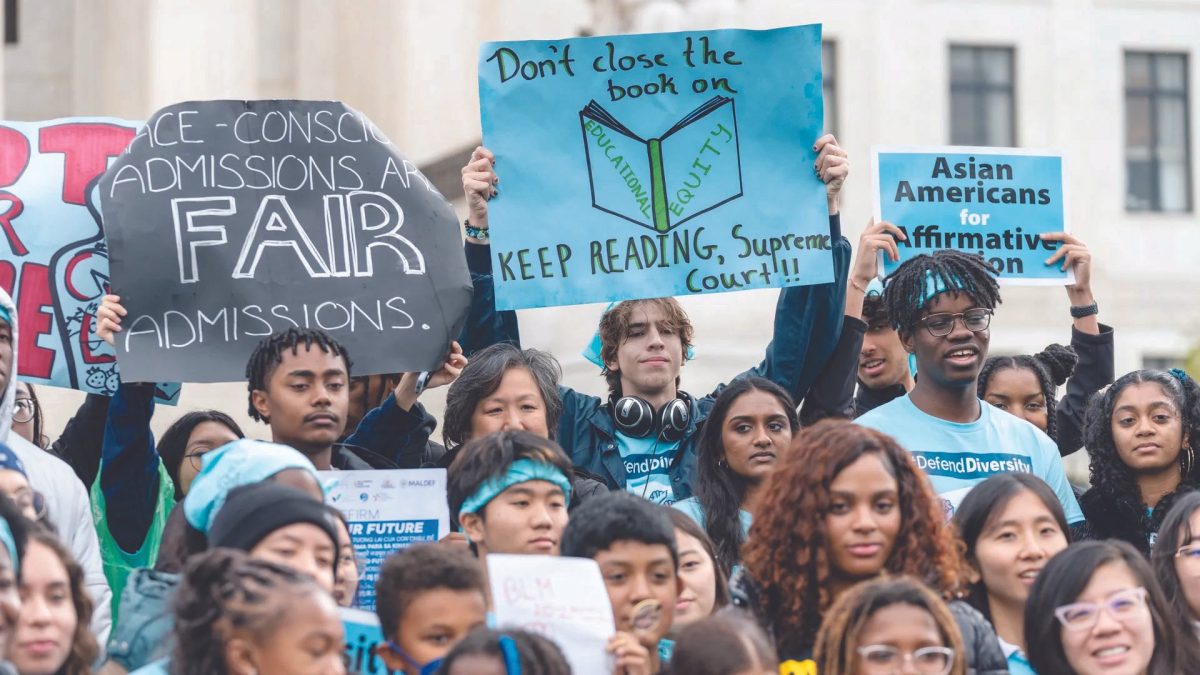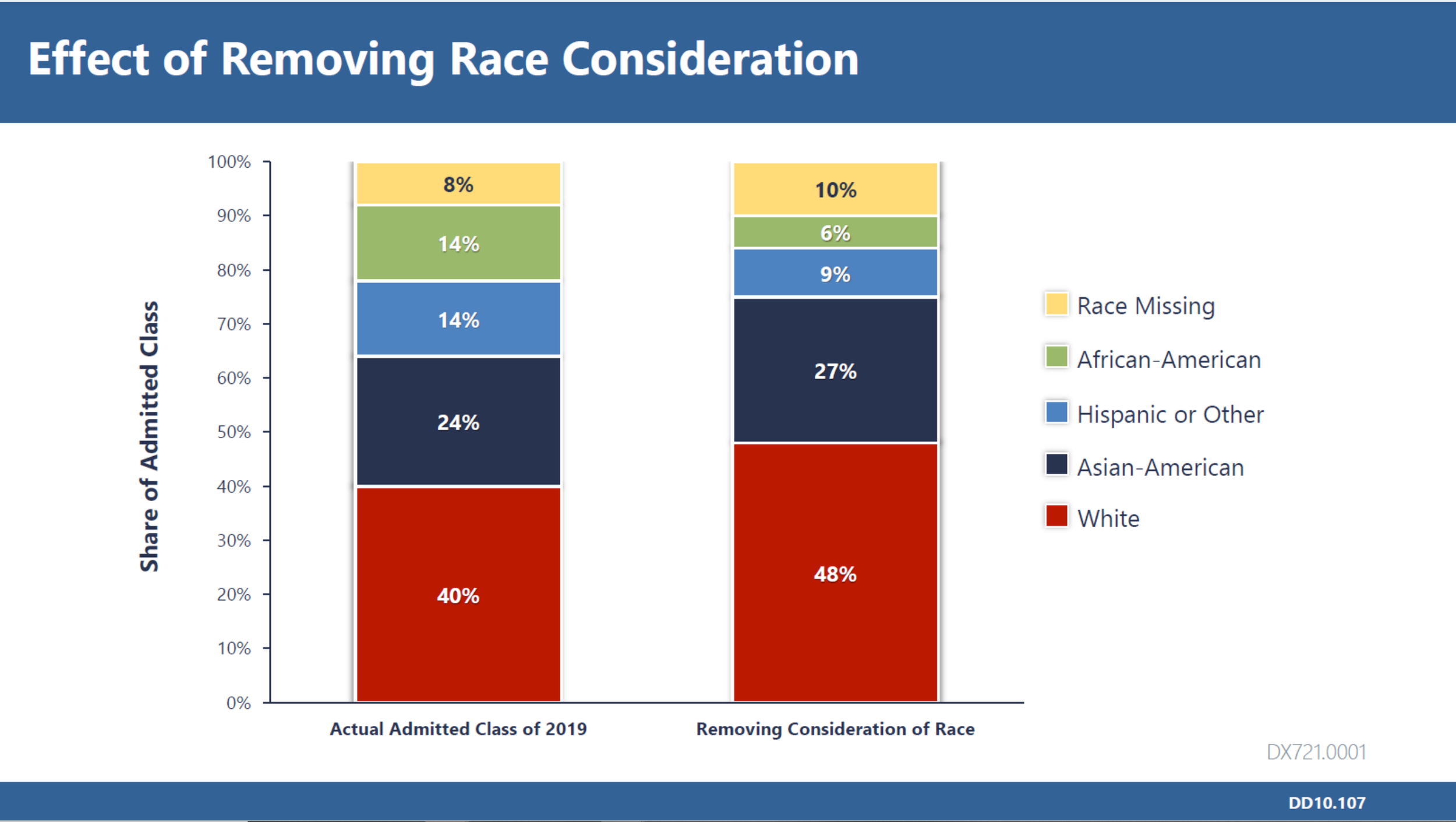Students protest the Students for Fair Admission’s case against affirmative action. // Photo courtesy of Eric Lee for The Washington Post via Getty Images.
Over the course of eight months, 40 years of legal precedent and progress toward diversity in education has been struck down by the Supreme Court. On Jun. 29, in the landmark case of Students for Fair Admissions, Inc. v. President and Fellows of Harvard College (SFFA), the Supreme Court came to a historic six to three decision rejecting race-conscious admissions in higher education.
The case was brought by activist and founder of the nonprofit organization Students for Fair Admissions (SFFA), Edward Blum. SFFA aims “to defend human and civil rights secured by law, including the right of individuals to equal protection under the law.” Blum and the SFFA filed separate lawsuits petitioning Harvard College and the University of North Carolina (UNC), claiming that the race-conscious admissions system utilized by both higher education institutions were illicit under the Fourteenth Amendment’s Equal Protection Clause and violated Title VI of the Civil Rights Act of 1964.
The term affirmative action first originated in 1961 when President John F. Kennedy issued an executive order to address racial disparity. The American Bar Association (ABA) stated that the order mandated “government contractors to ‘take affirmative action’ to realize the national goal of ‘nondiscrimination.’” Subsequently, colleges adopted affirmative action policies in the 1960s and 1970s for the purpose of “expand[ing] access to disadvantaged and underrepresented segments of society, including racial minorities.”
In general, affirmative action was used to “elevate groups that were historically disadvantaged [by] giving them access to resources and opportunities that were denied to them in the past and the ability to build up capital – to build up the same kind of starting point as members of more advantaged groups,” said Alex Sinha, associate professor of law at the Maurice A. Deane School of Law at Hofstra University. In the context of education, Sinha explained that affirmative action “take[s] into account certain features of applicants’ or candidates’ identities to start building in diversity into the classes and to start elevating groups that historically didn’t have access to educational opportunities, since those are so predictive of certain career pathways and success in their [students’] careers.”
Ever since its conception, critics of affirmative action have questioned the practicality of race-conscious admissions and disputed the policy methods higher education institutions have employed.
“There is also a negative stigma about affirmative action, that the people who get into a school or a job via affirmative action don’t deserve to be there,” said Iyanna Prioleau, a junior criminology and global studies major. “Affirmative action is supposed to help diversify the college and university population by giving minorities a better chance at getting into higher education.”
The precedent for affirmative action in education relied upon 20 years of cases (i.e. Bakke (1978), Grutter v. Bollinger (2003), Fisher I (2013) and Fisher II (2016)) that allowed for race-conscious admissions. The Court’s decision overrules prior cases that upheld that it is compelling for universities to assemble a diverse class. “If they [colleges and universities] employ race-conscious admissions in the right way, if they count race and ethnicity as one favorable factor among others, for their candidates – they can do that,” Sinha said. “It’s important for a variety of pedagogical reasons and other social reasons.”
An analysis performed by Harvard University based on modeling from the class of 2019 shows an 8% decrease in African American students and 5% decrease in Latinx students if race-concious admissions was removed. // Graphic courtesy of Harvard University.
In a Key Facts document about the case, Harvard explained that its admission policy “considers race as one factor among many in a whole-person review of each applicant.” Furthermore, Harvard asserted that the Court “has twice cited Harvard’s admission process as a model for how other colleges and universities can consider race consistent with the law and the Constitution.”
Prior to the case brought by the SFFA, the Court has permitted race-conscious admissions on the grounds that the program complies with “strict scrutiny, may never use race as a stereotype or negative, and must – at some point – end.”
Yet, after much deliberation, the Supreme Court found both Harvard College and UNC’s admissions program “permissible under the Equal Protection Clause.” The Court held that the principles of the Equal Protection Clause did not permit law-based distinctions based on race or color. The Court explained that their interpretation of the clause was “that the law in the States shall be the same for the black as for the white; that all persons, whether colored or white, shall stand equal before the laws of the States.”
Additionally, the Court stated that Harvard and UNC’s race-conscious admissions policies failed to operate in a manner that was “sufficiently measurable to permit judicial [review] under the rubric of strict scrutiny.”
The shift in the Court’s perspective on affirmative action, according to Sinha, is a result of the makeup of the Court. “In the last 20 years, nothing has changed materially that would explain that shift, except the composition of the Court,” Sinha said. “A majority of the justices on the Court now just don’t like the idea of affirmative action.” Since 2020, the Court contains six conservative justices and three liberal justices.
In their recently published article, Racial Justice Without Affirmative Action: Embracing International Law after SFFA v. Harvard, Sinha and his co-author Ian M. Kysel, an assistant clinical professor of law at Cornell Law School, shed light on the uniqueness of the SFFA case. Unlike previous cases that challenged affirmative action, the SFFA case neglected the role of international law. Specifically, under the United Nation’s International Convention on the Elimination of All Forms of Racial Discrimination treaty (ICERD), the United States is still obligated to “adopt immediate and effective measures, particularly in the fields of teaching, education, culture and information.” Kysel and Sinha suggested that under ICERD the U.S. is required to adopt “temporary measures designed to boost access to resources and opportunities for historically disadvantaged groups.” Until two months ago, one such measure included affirmative action.
After the release of the Court’s decision, President Joe Biden remarked that he “strongly disagree[s] with the Court’s decision.” The Departments of Justice and Education also offered guidance, suggesting that educational institutions continue their efforts to “seek the admission and graduation of diverse student bodies” through “targeted outreach, recruitment and pathway programs.”
However, despite the Biden administration’s active message on racial justice, Sinha stated that “they [the Biden administration] never really publicly acknowledged that we are legally obligated to do these things.” Kysel and Sinha noted that “the administration’s ‘friend of the court’ amicus brief in SFFA also omitted any reference to the [ICERD] treaty.” In other words, Sinha explained that the administration never explicitly recognized “that we signed and ratified this treaty [ICERD], for almost thirty years, we’ve been bound to eliminate racial discrimination both functionally and deliberately.”
During the trial, the SFFA suggested that higher education institutions use socioeconomic status as a substitute for race. William Lee, Harvard University’s lead trial counsel, disclosed that Harvard had considered the SFFA’s alternative propositions and concluded that they would not “permit Harvard to achieve its educational goals as well as build the diverse learning community central to its educational mission if race were not taken into consideration.” In the Harvard Gazette, Lee stated that an analysis performed by economist David Card “found that such an approach would result in a class that was less academically qualified and would have 40% fewer African American students.”
“If affirmative action was class-based, it could still help some minority students get into higher education while also helping poor students in general have a higher chance of attending good colleges,” Prioleau said.
“The goal from the anti-affirmative action position is for there to be race blind policies, race neutral policies [or] colorblind policies, where we just don’t don’t give any credence to our awareness of racial or ethnic identity,” said Cornell Craig, Hofstra University’s chief diversity and inclusion officer. “History has shown that when you do have colorblind or race-neutral approaches that dominates perspectives, dominant identities will over represent and identities of minoritized communities – of people of color, even of women – will be well overrepresented in exclusion.”
Although the nation has been focused on remedying educational diversity at the higher institution level, Craig suggested that the public also focus on the K-12 education system. “We are asking universities, really on the back end of the education journey, to make up for other inequities that are throughout the education system writ large,” Craig said. “When we’re talking about competency or qualifications to even apply to a university, that’s something that has nothing to do with the university – that has to do with K-12.” According to Craig, these issues include school funding, redlining and ongoing segregation within communities.
Regarding Hofstra University, the SFFA case is not foreseen as having a great impact on the university’s approach to recruiting students. According to Craig, Hofstra did not have an affirmative action policy. “We really use a holistic approach,” Craig said. “So that’s looking at all the qualities that a student brings to their admission application.” A message issued by president Susan Poser on Jun. 29, stated that Hofstra “will continue to follow a holistic admissions process that has helped to create a campus environment that embodies our community’s core values of diversity, equity, inclusion, and multiculturalism.”
Consequently, the Court’s momentous decision bequeaths the public with anxiety as it awaits the impact of upending affirmative action. Cara McClellan, the director of the Advocacy for Racial and Civil Justice Clinic and an associate professor of law at the University of Pennsylvania Carey Law School, told CNBC that “there’s a real risk that the incoming classes will look different.” She predicted that “without considering race, there would be a reduction in the number of underrepresented students of color.” In 1996, the University of California witnessed a 12% decrease in underrepresented students after eliminating affirmative action in its admission policy. The SFFA case has resulted in a period of uncertainty for higher education institutions as they await to witness the impact on their campus diversity.
Those who are interested on learning more about the recent SCOTUS decision are advised to attend the Affirmative Action Symposium hosted by Hofstra’s Office of Equity and Inclusion on Oct. 10, at the Guthart Theater.








